betterton
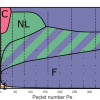 Hui-Shun Kuan's paper "Hysteresis, reentrance, and glassy dynamics in systems of self-propelled rods" was accepted for publication in Physical Review E.
Hui-Shun Kuan's paper "Hysteresis, reentrance, and glassy dynamics in systems of self-propelled rods" was accepted for publication in Physical Review E. Robert Blackwell's paper "Microscopic origins of anisotropic active stress in motor-driven nematic liquid crystals" was published online in Soft Matter.
Robert Blackwell's paper "Microscopic origins of anisotropic active stress in motor-driven nematic liquid crystals" was published online in Soft Matter.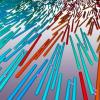 We study a physical model of filaments, crosslinking motors, and static crosslinkers to dissect the microscopic mechanisms of active stress generation in a two-dimensional system of orientationally aligned rods.
We study a physical model of filaments, crosslinking motors, and static crosslinkers to dissect the microscopic mechanisms of active stress generation in a two-dimensional system of orientationally aligned rods.- Microscopic motor activity causes polarity-dependent interactions between motor proteins and microtubules in reconstituted cytoskeletal active matter.
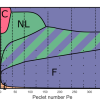 Non-equilibrium active matter made up of self-driven particles with short-range repulsive interactions exhibits collective motion and nonequilibrium order-disorder transitions.
Non-equilibrium active matter made up of self-driven particles with short-range repulsive interactions exhibits collective motion and nonequilibrium order-disorder transitions.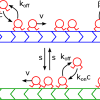 Biopolymers serve as one-dimensional tracks on which motor proteins move. These phenomena have inspired theoretical models of one-dimensional transport, crowding, and jamming.
Biopolymers serve as one-dimensional tracks on which motor proteins move. These phenomena have inspired theoretical models of one-dimensional transport, crowding, and jamming. Meredith Betterton was awarded a National Science Foundation grant DMR 1551095, "EAGER: Biophysical theory of mitotic spindle length instability and self assembly."
Meredith Betterton was awarded a National Science Foundation grant DMR 1551095, "EAGER: Biophysical theory of mitotic spindle length instability and self assembly."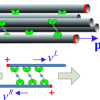 Microtubules and motor proteins can form new “bioactive” liquid-crystalline fluids that are intrinsically out of equilibrium and which display complex flows and defect dynamics.
Microtubules and motor proteins can form new “bioactive” liquid-crystalline fluids that are intrinsically out of equilibrium and which display complex flows and defect dynamics.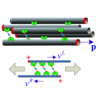 Robert Blackwell's paper (with Tony Gao) "Multiscale polar theory of microtubule and motor-protein assemblies" was published in Physical Review Letters.
Robert Blackwell's paper (with Tony Gao) "Multiscale polar theory of microtubule and motor-protein assemblies" was published in Physical Review Letters.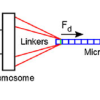 When chromosomes are being separated in preparation for cell division, their motions are slow relative to the speed at which many motor enzymes can move their cellular cargoes and at which microtubules depolymerize.
When chromosomes are being separated in preparation for cell division, their motions are slow relative to the speed at which many motor enzymes can move their cellular cargoes and at which microtubules depolymerize.

